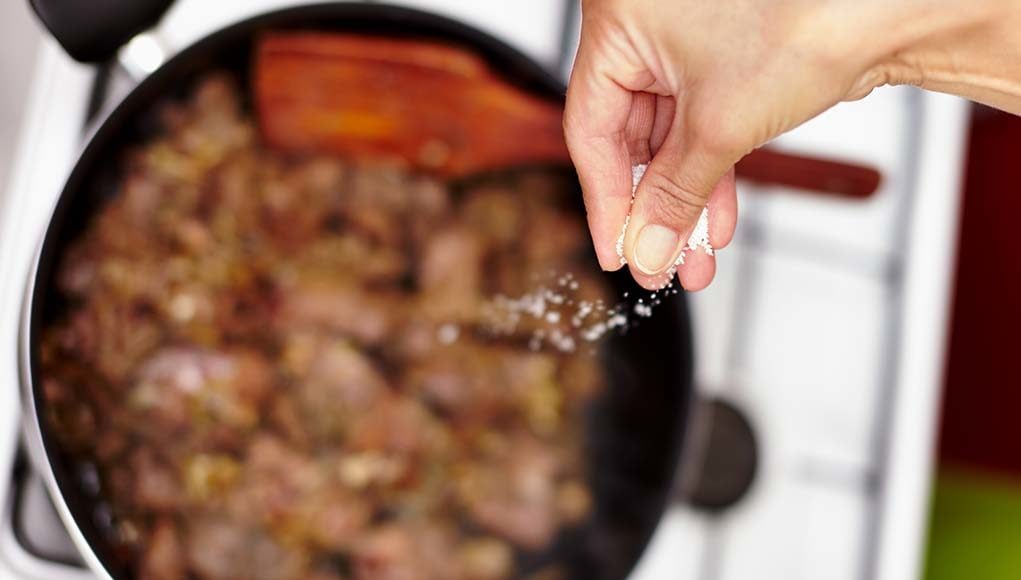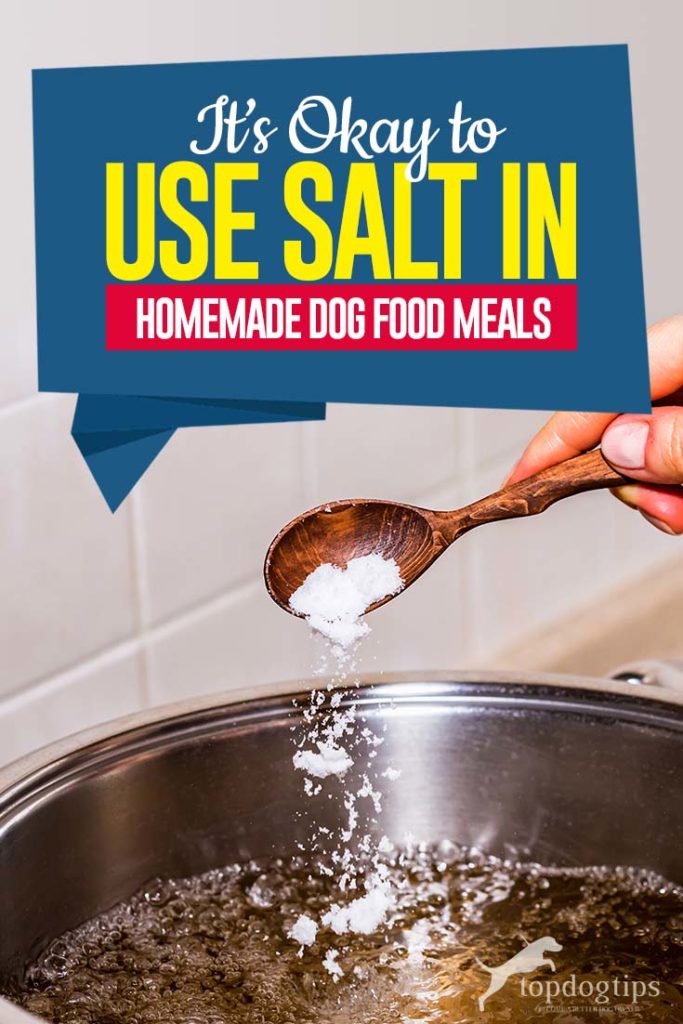Those of you reading my homemade dog food recipes here on Top Dog Tips will sometimes email me, asking why do I use salt. Isn't salt dangerous to dogs? Not really. In small amounts, salt isn't only safe for dogs but, in fact, beneficial; it's recommended to add it to your recipes to make them more well-balanced. This article explains why you can and should use safe amounts of salt in homemade dog food recipes.
Why Is Salt Controversial?
Salt (sodium chloride) is used in many perishable foods, including commercial kibble (source), as a natural preservative that prevents the proliferation of microbes (mold and bacteria). It does this by “sucking” the moisture from it, leaving it too dry to allow microbial growth.
For the same reason that salt preserves food, this mineral, when used in large doses, is dangerous to dogs and can lead to salt toxicity or hypernatremia and hypertension (source). Too much salt for dogs can cause them to become very thirsty and urinate more frequently, which could lead to dehydration (source).
When large doses of sodium chloride have been ingested by the dog to the point of toxicity, your pet may also experience vomiting, diarrhea, muscle tremors, depression, elevated temperature, seizures, and even death.
However, most animals can tolerate a higher concentration of salt as long as they have a continuous supply of fresh water to flush it from their system.
So How Much is Too Much?
Salt toxicity in dogs will occur when the animal consumes too much and is unable to rehydrate and flush out the sodium from the body through the use of liquids.
The oral lethal dose of salt in dogs is:
approx. 2 g/lb (4 g/kg)
Salt in itself is not something you would normally free-feed to a dog. If you occasionally give “human snacks” to your pup, remember that salt is found in very high amounts in a large number of human foods and most commonly in:
- Cheese
- Pretzels
- Potato chips
- Crackers
- Pre-packaged popcorn
- Cured meats
Most of these foods are very high in salt/sodium, and while humans can tolerate these high doses, dogs cannot. Therefore, avoid giving your dog any of these or similar foods that you know are high in sodium. When it comes to salt, always pay attention to how much your pet is consuming.
Safe Amounts of Salt In Homemade Dog Food
 Dogs and their ancestors, wolves, would consume sodium in the wild by ingesting prey (deer or rabbit), which contains anywhere between 2.5g/kg to 10g/kg of dry matter.
Dogs and their ancestors, wolves, would consume sodium in the wild by ingesting prey (deer or rabbit), which contains anywhere between 2.5g/kg to 10g/kg of dry matter.
Most commercial dog food brands will typically contain anywhere between 0.5g/1000 kcal to 2.5g/1000 kcal or 2-10g/kg of dry matter. Wet dog food will contain slightly more sodium than dry dog food (source).
Some studies have analyzed commercial foods and found that certain brands contain too much sodium based on FEDIAF standards, with some foods exceeding the recommended daily dosage by 10 times (source).
For this reason, in some cases, it may be better to switch your pet to homemade cooking so you can monitor for safe amounts. In the case of using salt in homemade dog food meals, there's a good and safe amount that holistic veterinarians recommend, which is at least 0.3% sodium for a well-balanced meal.
The minimum daily sodium intake for dogs should be around 13mg/kg body weight, which is about 0.2g/1000kcal (or 200mg/1000kcal).
That's 0.25g of salt per 100g of food minimum, or 1.5g of salt per 100g of food for maintenance and to support normal growth and development.
These doses are likely to be safe for healthy adult dogs and will allow you to reap some of the health benefits salt can provide to your pet. For dogs with certain health conditions or those on medication, salt doses must be adjusted – discuss this with your veterinarian.
Note: Puppies, lactating, and pregnant dogs may require a higher amount of sodium than adult dogs, as recommended by your veterinarian. Very active breeds will require approximately 3-5 times more sodium than more sedentary dog breeds.
Be Mindful of Existing Health Conditions
Just like with humans, when it comes to dogs, salt can be more dangerous for some than for others (source, source, source). For example:
Kidney Disease. Dogs with impaired kidney function should not be given salt at all, and when they are fed any sodium, it must be under strict vet supervision.
Heart Disease. Large doses of salt can put a bigger strain on the heart and increase blood pressure in dogs.
Liver Disease. Sodium can cause a buildup of fluid in the abdomen.
Potential Benefits of Salt for Dogs
The benefits of salt for dogs are to maintain healthy body function. It's a mineral that most animals require in their diet, and all dogs need some amount of sodium in food.
When given in proper amounts, salt plays an important role in the healthy function and maintenance of a dog's vital organs and areas like cellular functions, fluid balance, acid-base balance, and nerve signal transmission (source).
Dogs need chloride to produce the stomach’s hydrochloric acid, which helps with digestion. When your dog has a salt deficiency, it can cause abnormalities in their heart’s rhythm, the dog will become restless, have dry mucous membranes, have an abnormal fluid intake, which can also lead to excess urine production.
Salt is not something most dogs will willingly ingest in large quantities, so the chances of your canine overdosing on this mineral are slim as well. Some studies showed that test dogs wouldn't even ingest water with large amounts of salt in it (though others have shown salt toxicity in dogs that spend too much time near the ocean).
READ NEXT: A Science-based Guide to Home-Cooked Dog Food Recipes
Want to share this?













